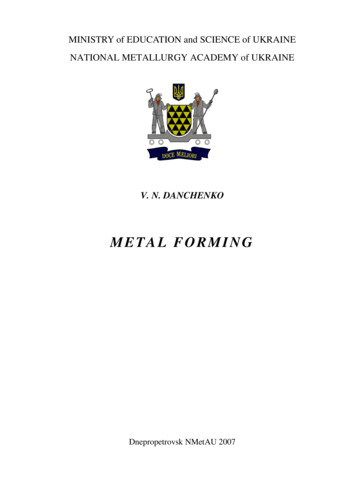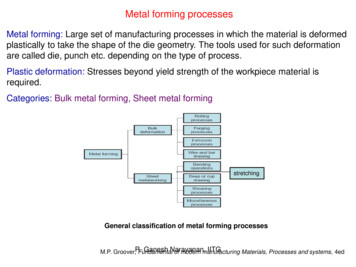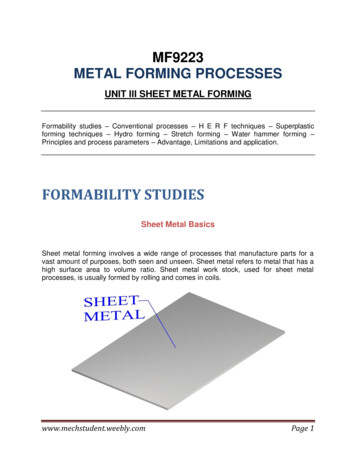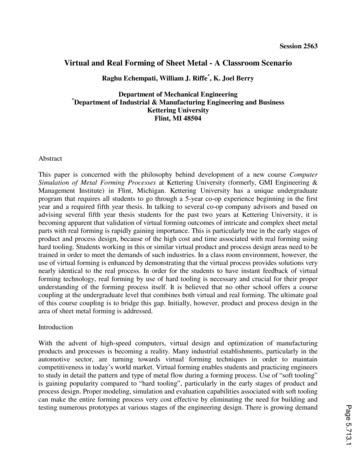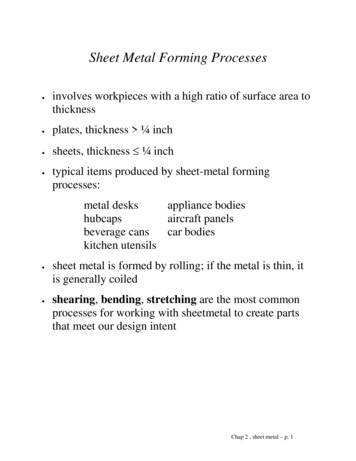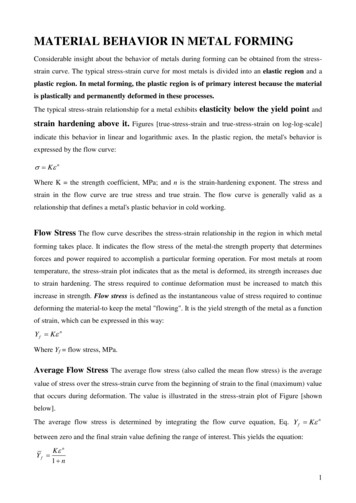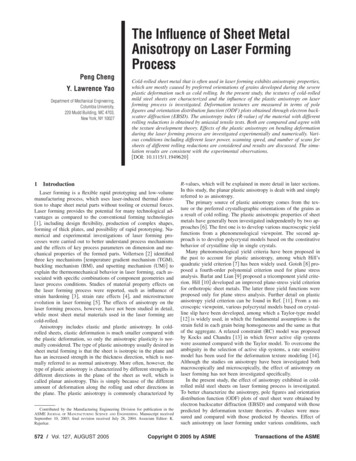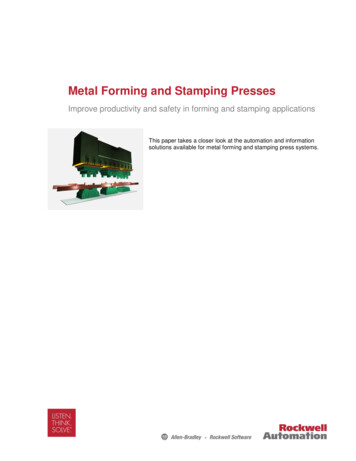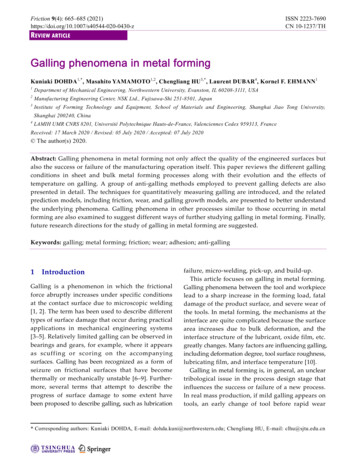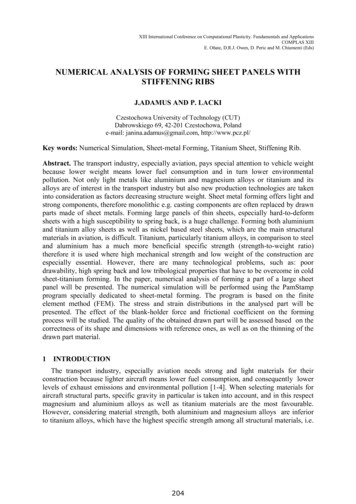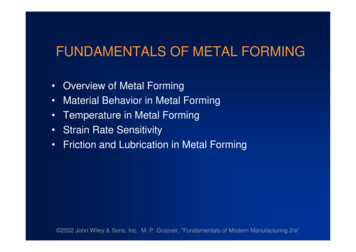
Transcription
FUNDAMENTALS OF METAL FORMING Overview of Metal Forming Material Behavior in Metal Forming Temperature in Metal Forming Strain Rate Sensitivity Friction and Lubrication in Metal Forming 2002 John Wiley & Sons, Inc. M. P. Groover, “Fundamentals of Modern Manufacturing 2/e”
Metal FormingLarge group of manufacturing processes in whichplastic deformation is used to change the shape ofmetal workpieces The tool, usually called a die, applies stresses thatexceed yield strength of metal The metal takes a shape determined by the geometryof the die 2002 John Wiley & Sons, Inc. M. P. Groover, “Fundamentals of Modern Manufacturing 2/e”
Stresses in Metal Forming Stresses to plastically deform the metal are usuallycompressive Examples: rolling, forging, extrusion However, some forming processes Stretch the metal (tensile stresses) Others bend the metal (tensile and compressive) Still others apply shear stresses 2002 John Wiley & Sons, Inc. M. P. Groover, “Fundamentals of Modern Manufacturing 2/e”
Material Properties in Metal Forming Desirable material properties: Low yield strength and high ductility These properties are affected by temperature: Ductility increases and yield strength decreaseswhen work temperature is raised Other factors: Strain rate and friction 2002 John Wiley & Sons, Inc. M. P. Groover, “Fundamentals of Modern Manufacturing 2/e”
Bulk Deformation Processes Characterized by significant deformations andmassive shape changes "Bulk" refers to workparts with relatively low surfacearea-to-volume ratios Starting work shapes include cylindrical billets andrectangular bars 2002 John Wiley & Sons, Inc. M. P. Groover, “Fundamentals of Modern Manufacturing 2/e”
Figure 18.2 –Basic bulk deformation processes: (a) rolling 2002 John Wiley & Sons, Inc. M. P. Groover, “Fundamentals of Modern Manufacturing 2/e”
Figure 18.2 –Basic bulk deformation processes: (b) forging 2002 John Wiley & Sons, Inc. M. P. Groover, “Fundamentals of Modern Manufacturing 2/e”
Figure 18.2 –Basic bulk deformation processes: (c) extrusion 2002 John Wiley & Sons, Inc. M. P. Groover, “Fundamentals of Modern Manufacturing 2/e”
Figure 18.2 –Basic bulk deformation processes: (d) drawing 2002 John Wiley & Sons, Inc. M. P. Groover, “Fundamentals of Modern Manufacturing 2/e”
Sheet Metalworking Forming and related operations performed on metalsheets, strips, and coils High surface area-to-volume ratio of starting metal,which distinguishes these from bulk deformation Often called pressworking because presses performthese operations Parts are called stampings Usual tooling: punch and die 2002 John Wiley & Sons, Inc. M. P. Groover, “Fundamentals of Modern Manufacturing 2/e”
Figure 18.3 - Basic sheet metalworking operations: (a) bending 2002 John Wiley & Sons, Inc. M. P. Groover, “Fundamentals of Modern Manufacturing 2/e”
Figure 18.3 - Basic sheet metalworking operations: (b) drawing 2002 John Wiley & Sons, Inc. M. P. Groover, “Fundamentals of Modern Manufacturing 2/e”
Figure 18.3 - Basic sheet metalworking operations: (c) shearing 2002 John Wiley & Sons, Inc. M. P. Groover, “Fundamentals of Modern Manufacturing 2/e”
Material Behavior in Metal Forming Plastic region of stress-strain curve is primary interestbecause material is plastically deformed In plastic region, metal's behavior is expressed by theflow curve: K nwhere K strength coefficient; and n strainhardening exponent Stress and strain in flow curve are true stress andtrue strain 2002 John Wiley & Sons, Inc. M. P. Groover, “Fundamentals of Modern Manufacturing 2/e”
Flow Stress For most metals at room temperature, strengthincreases when deformed due to strain hardening Flow stress instantaneous value of stress requiredto continue deforming the materialYf K nwhere Yf flow stress, that is, the yield strength as afunction of strain 2002 John Wiley & Sons, Inc. M. P. Groover, “Fundamentals of Modern Manufacturing 2/e”
Average Flow StressDetermined by integrating the flow curve equationbetween zero and the final strain value defining therange of interestK nYf 1 nwhere Yf average flow stress; and maximumstrain during deformation process 2002 John Wiley & Sons, Inc. M. P. Groover, “Fundamentals of Modern Manufacturing 2/e”
Temperature in Metal Forming For any metal, K and n in the flow curve depend ontemperature Both strength and strain hardening are reduced athigher temperatures In addition, ductility is increased at highertemperatures 2002 John Wiley & Sons, Inc. M. P. Groover, “Fundamentals of Modern Manufacturing 2/e”
Temperature in Metal Forming Any deformation operation can be accomplished withlower forces and power at elevated temperature Three temperature ranges in metal forming: Cold working Warm working Hot working 2002 John Wiley & Sons, Inc. M. P. Groover, “Fundamentals of Modern Manufacturing 2/e”
Cold Working Performed at room temperature or slightly above Many cold forming processes are important massproduction operations Minimum or no machining usually required These operations are near net shape or net shapeprocesses 2002 John Wiley & Sons, Inc. M. P. Groover, “Fundamentals of Modern Manufacturing 2/e”
Advantages of Cold Forming vs.Hot Working Better accuracy, closer tolerances Better surface finish Strain hardening increases strength and hardness Grain flow during deformation can cause desirabledirectional properties in product No heating of work required 2002 John Wiley & Sons, Inc. M. P. Groover, “Fundamentals of Modern Manufacturing 2/e”
Disadvantages of Cold Forming Higher forces and power required Surfaces of starting workpiece must be free of scaleand dirt Ductility and strain hardening limit the amount offorming that can be done In some operations, metal must be annealed toallow further deformation In other cases, metal is simply not ductile enoughto be cold worked 2002 John Wiley & Sons, Inc. M. P. Groover, “Fundamentals of Modern Manufacturing 2/e”
Warm Working Performed at temperatures above room temperaturebut below recrystallization temperature Dividing line between cold working and warm workingoften expressed in terms of melting point: 0.3Tm, where Tm melting point (absolutetemperature) for metal 2002 John Wiley & Sons, Inc. M. P. Groover, “Fundamentals of Modern Manufacturing 2/e”
Advantages of Warm Working Lower forces and power than in cold working More intricate work geometries possible Need for annealing may be reduced or eliminated 2002 John Wiley & Sons, Inc. M. P. Groover, “Fundamentals of Modern Manufacturing 2/e”
Hot Working Deformation at temperatures above recrystallizationtemperature Recrystallization temperature about one-half ofmelting point on absolute scale In practice, hot working usually performedsomewhat above 0.5Tm Metal continues to soften as temperatureincreases above 0.5Tm, enhancing advantage ofhot working above this level 2002 John Wiley & Sons, Inc. M. P. Groover, “Fundamentals of Modern Manufacturing 2/e”
Why Hot Working?Capability for substantial plastic deformation of themetal - far more than possible with cold working orwarm working Why? Strength coefficient is substantially less than atroom temperature Strain hardening exponent is zero (theoretically) Ductility is significantly increased 2002 John Wiley & Sons, Inc. M. P. Groover, “Fundamentals of Modern Manufacturing 2/e”
Advantages of Hot Working vs. Cold Working Workpart shape can be significantly altered Lower forces and power required Metals that usually fracture in cold working can behot formed Strength properties of product are generally isotropic No strengthening of part occurs from work hardening Advantageous in cases when part is to besubsequently processed by cold forming 2002 John Wiley & Sons, Inc. M. P. Groover, “Fundamentals of Modern Manufacturing 2/e”
Disadvantages of Hot Working Lower dimensional accuracy Higher total energy required (due to the thermalenergy to heat the workpiece) Work surface oxidation (scale), poorer surface finish Shorter tool life 2002 John Wiley & Sons, Inc. M. P. Groover, “Fundamentals of Modern Manufacturing 2/e”
Strain Rate Sensitivity Theoretically, a metal in hot working behaves like aperfectly plastic material, with strain hardeningexponent n 0 The metal should continue to flow at the sameflow stress, once that stress is reached However, an additional phenomenon occursduring deformation, especially at elevatedtemperatures: Strain rate sensitivity 2002 John Wiley & Sons, Inc. M. P. Groover, “Fundamentals of Modern Manufacturing 2/e”
What is Strain Rate? Strain rate in forming is directly related to speed ofdeformation v Deformation speed v velocity of the ram or othermovement of the equipmentStrain rate is defined:.v hwhere true strain rate; and h instantaneous heightof workpiece being deformed 2002 John Wiley & Sons, Inc. M. P. Groover, “Fundamentals of Modern Manufacturing 2/e”
Evaluation of Strain Rate In most practical operations, valuation of strain rate iscomplicated by Workpart geometry Variations in strain rate in different regions of thepart Strain rate can reach 1000 s-1 or more for somemetal forming operations 2002 John Wiley & Sons, Inc. M. P. Groover, “Fundamentals of Modern Manufacturing 2/e”
Effect of Strain Rate on Flow Stress Flow stress is a function of temperature At hot working temperatures, flow stress alsodepends on strain rate As strain rate increases, resistance to deformationincreases This effect is known as strain-rate sensitivity 2002 John Wiley & Sons, Inc. M. P. Groover, “Fundamentals of Modern Manufacturing 2/e”
Figure 18.5 - (a) Effect of strain rate on flow stress at anelevated work temperature. (b) Same relationshipplotted on log-log coordinates 2002 John Wiley & Sons, Inc. M. P. Groover, “Fundamentals of Modern Manufacturing 2/e”
Strain Rate Sensitivity EquationmYf C where C strength constant (similar but not equal tostrength coefficient in flow curve equation), and m strain-rate sensitivity exponent 2002 John Wiley & Sons, Inc. M. P. Groover, “Fundamentals of Modern Manufacturing 2/e”
Figure 18.6 - Effect oftemperature on flow stressfor a typical metal. Theconstant C in Eq. (18.4),indicated by the intersectionof each plot with the verticaldashed line at strain rate 1.0, decreases, and m(slope of each plot)increases with increasingtemperature 2002 John Wiley & Sons, Inc. M. P. Groover, “Fundamentals of Modern Manufacturing 2/e”
Observations about Strain RateSensitivity Increasing temperature decreases C, increases m At room temperature, effect of strain rate is almostnegligible Flow curve is a good representation of materialbehavior As temperature increases, strain rate becomesincreasingly important in determining flow stress 2002 John Wiley & Sons, Inc. M. P. Groover, “Fundamentals of Modern Manufacturing 2/e”
Friction in Metal Forming In most metal forming processes, friction isundesirable: Metal flow is retarded Forces and power are increased Wears tooling faster Friction and tool wear are more severe in hot working 2002 John Wiley & Sons, Inc. M. P. Groover, “Fundamentals of Modern Manufacturing 2/e”
Lubrication in Metal Forming Metalworking lubricants are applied to tool-workinterface in many forming operations to reduceharmful effects of friction Benefits: Reduced sticking, forces, power, tool wear Better surface finish Removes heat from the tooling 2002 John Wiley & Sons, Inc. M. P. Groover, “Fundamentals of Modern Manufacturing 2/e”
Considerations in Choosing a Lubricant Type of forming process (rolling, forging, sheet metaldrawing, etc.) Hot working or cold working Work material Chemical reactivity with tool and work metals Ease of application Cost 2002 John Wiley & Sons, Inc. M. P. Groover, “Fundamentals of Modern Manufacturing 2/e”
Sheet Metalworking Forming and related operations performed on metal sheets, strips, and coils High surface area-to-volume ratio of starting metal, . Material Behavior in Metal Forming Plastic region of stress-strain curve is
